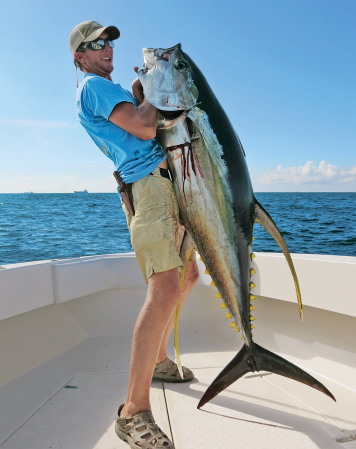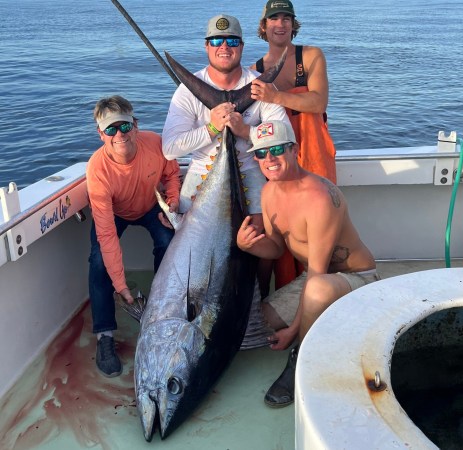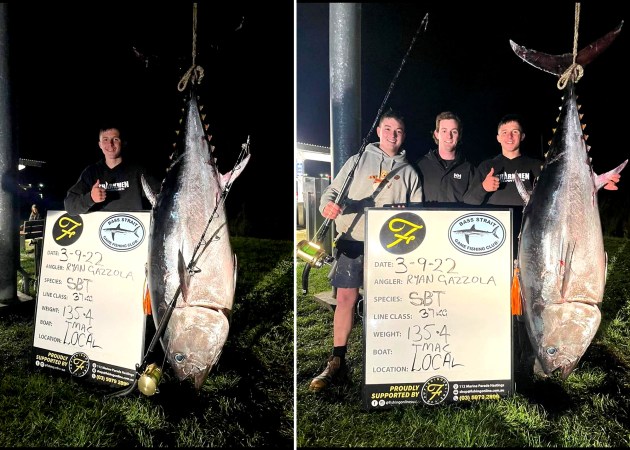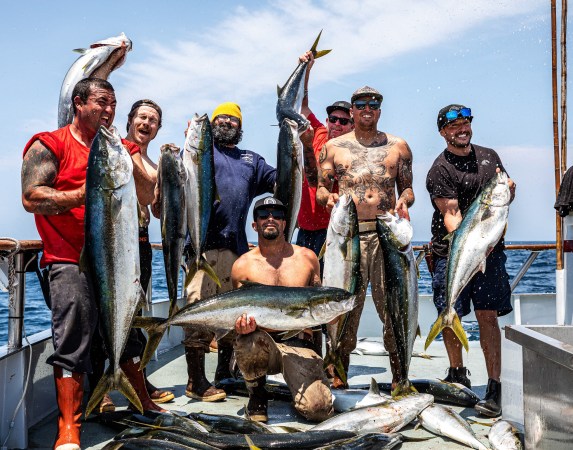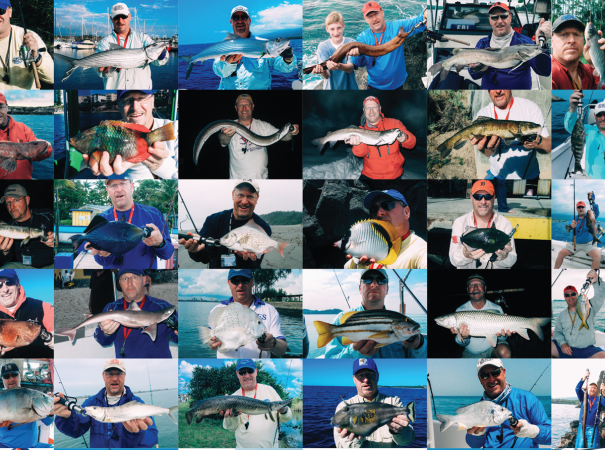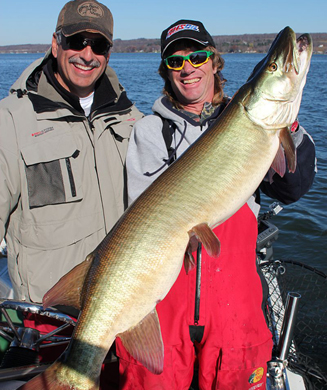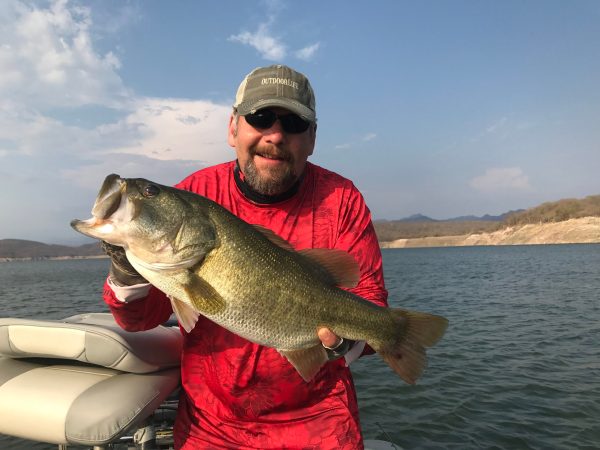Few fish are more impressive than big tuna when it comes to power and athleticism. Their fight can leave anglers with numb arms and busted tackle. And when it comes to trophy quality on the plate, few fish compare with tasty tuna, whether deck-side as sashimi with a little soy and lemon juice or grilled rare as ahi steaks.
Here’s a look at the biggest tuna of all time, as recorded by the International Gamefish Association.
Bigeye Tuna: (Atlantic) 392 pounds, 6 ounces; (Pacific) 435 pounds

Bigeye are classified into two subspecies, the Atlantic and Pacific. Dieter Vogel holds the all-tackle world record for the Atlantic with a 392-pound, 6-ounce bigeye caught July 25, 1996 while fishing near Puerto Rico de Gran Canaria, Spain, an island off the northwestern tip of Africa. The fish measured 83.07 inches long with a 59-inch girth. Vogel was using a Fenwick with a Shimano 50W reel spooled with 50-pound Berkley Trilene. The fish hit a trolled streamer.
The Pacific all-tackle record is held by Dr. Russel Lee, with a 435-pound bigeye caught April 17, 1957 off Cabo Blanco, Peru. Lee’s tuna was 93 inches long with a 64-inch girth. Lee was wielding a Sila Flex rod with an Ocean City 14/0 reel spooled with Sunset line. The tuna hit a bonito.
Like most tuna, bigeye like warm, temperate waters. They’re found in the Atlantic, Pacific, and Indian Oceans. Bigeyes were once considered a variation of the yellowfin tuna but differences such as their shorter second dorsal and anal fins set them apart. Bigeye are schooling pelagic fish that make extensive migrations. They’re often caught in the same waters at the same time as yellowfin. While this tuna generally runs deep during the day, they can be enticed closer to the surface with the right lures. Trolling deep with squid, mullet or other small baits, or artificial lures and live-bait fishing in deep waters with similar baits is productive. The meat is very much like that of a yellowfin—delicious.
Blackfin Tuna: 49 pounds, 6 ounces

Capt. Matthew E. Pullen holds the all-tackle blackfin record with a 49-pound 6-ounce fish caught April 6, 2006 off Marathon, Florida. Pullen’s blackin was 41 inches long with a 32-inch girth. He caught the tuna on an Offshore Angler rod with a Shimano reel. He was using a pinfish for bait.
Another noteworthy world record is found in the 4-pound line class. Bill Riesenfeld caught a 28-pound blackfin on the light line. He caught the tuna on May 12, 1988 off Key West, Florida. It was 36 inches long, with a girth of 24 inches. Riesenfeld was using a Knightstik rod and a Daiwa BG 15 spinning reel spooled with Ande line. The bait is listed simply as a “fish.”
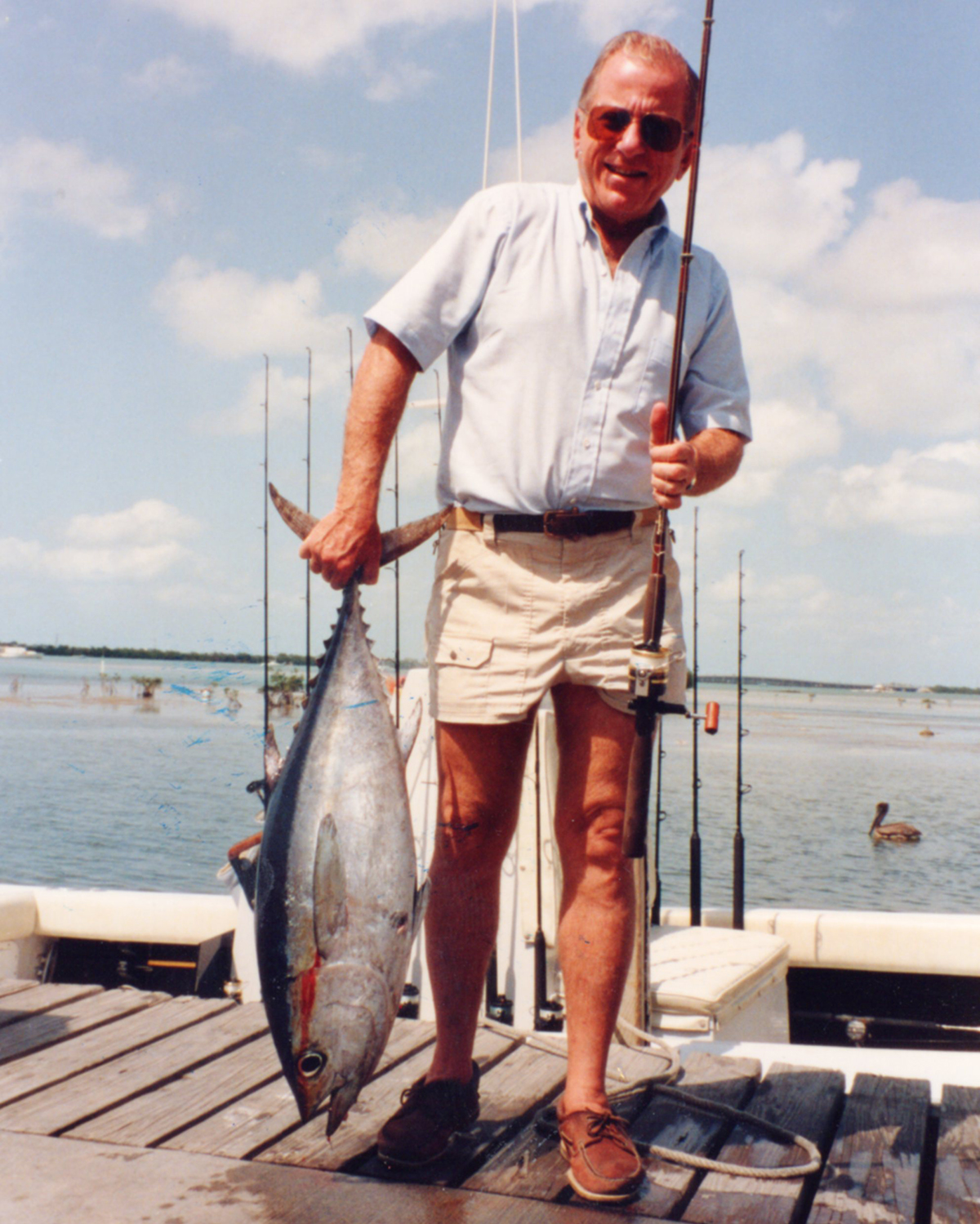
The blackfin tuna is sometimes referred to as the Bermuda tuna or blackfinned albacore. Its range includes the tropical and warm temperate waters of the western Atlantic Ocean from North Carolina to Rio de Janeiro, Brazil, including the Caribbean Sea and the Gulf of Mexico. Some have been caught as far north as Massachusetts. A blackfin’s finlets are uniformly dark, without a touch of the bright lemon yellow often seen in other tuna. These schooling fish are often caught near the surface and can provide loads of light-tackle fun.
Bluefin Tuna: 1,496 pounds

Ken Fraser holds the all-tackle world record with a 1,496-pound fish he caught on Oct. 26, 1979 off Aulds Cove, Nova Scotia, Canada. The massive bluefin was 128.50 inches long with a 99-inch girth. Fraser was using a Fenwick rod with a Penn International 14/0 reel spooled with 130-pound Garcia line. He was trolling a mackerel when the monster bit.
A notable fly-fishing world record—in the 16-pound tippet class—is held by Raz Reid, who caught a 101-pound, 8-ounce bluefin on February 22, 1996 while fishing off Hatteras in North Carolina. Reid’s fish was 56 inches long with a 38-inch girth. He was using a Sage rod with a Billy Pate Bluefin reel. The line was 15-pound Mason.
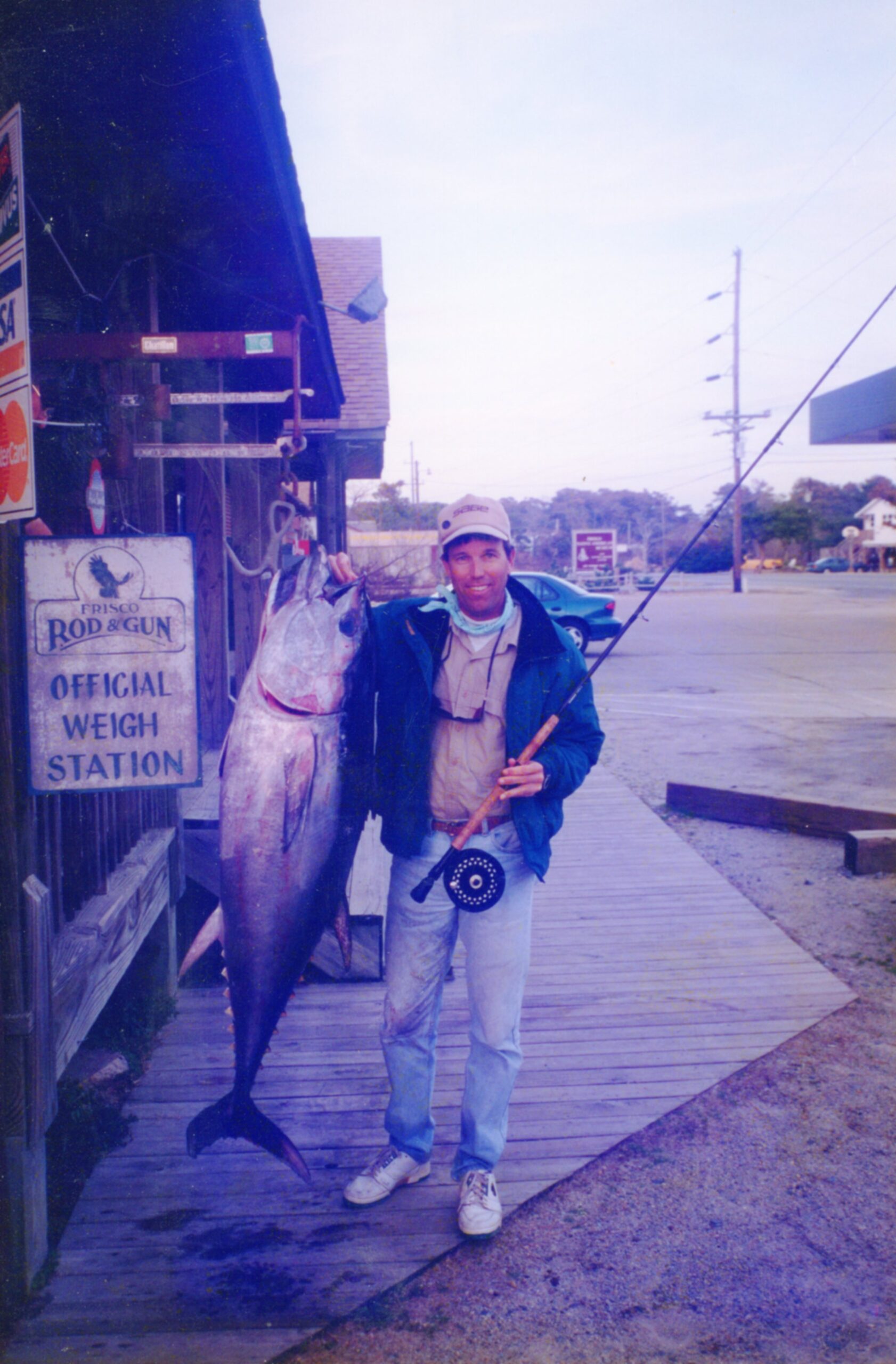
There are three species of bluefin tuna worldwide. The highly migratory bluefins are the behemoths of the tuna world, with adults dwarfing their many cousins. This record refers to the fish sometimes called the Atlantic bluefin tuna, tunny fish, or horse mackerel. They are found in subtropical and temperate waters of the north Pacific Ocean, the North Atlantic Ocean, and in the Mediterranean and Black Seas. The bluefin is a television star, made famous by shows depicting commercial captains following the fish as they transit vast ranges seeking the right water temperatures and their favored forage fish species. Besides the ample size of adult fish, bluefin are distinguished from most tuna subspecies by their short pectoral fins, which extend back to the first dorsal fin’s eleventh or twelfth spine. Bluefins grow fast; a 14-year-old can be 8-feet long and weigh 700 pounds.
Pacific Bluefin Tuna: 907 pounds, 6 ounces

Donna Pascoe is the all-tackle record holder with a 907-pound, 6-ounce Pacific bluefin caught Feb. 19, 2014 off Three Kings, New Zealand. Pascoe’s tuna was 144.49 inches long with a 42-inch girth. Pascoe used a Kilwell rod, Shimano reel and 130-pound Momoi line to catch the bluefin. The big tuna hit a skipjack tuna used as bait.
Besides the bluefin mentioned above, the other two bluefin species are the Pacific and southern bluefin. However, differentiating between the two species is such a challenge that the IGFA is now requiring that a genetic analysis accompany any application for a purported Pacific bluefin caught in the southern hemisphere that weighs less than the current southern bluefin all-tackle record of 348 pounds. Pacific bluefin are increasingly showing up in southern waters. The Pacific bluefin tuna can often, but not always, be distinguished from southern bluefin by the dark color of their caudal keels at the base of the tail. The Southern bluefins usually have yellow coloration there.
Southern Bluefin: 369 pounds, 4 ounces

Phil Body caught his all-tackle world record fish off the coast of Tathra, Australia on July 9, 2009. The 369-pound, 4-ounce fish measured 77.95 inches long with a 59-inch girth.
The southern bluefin is sometimes called the Japanese Central Pacific bluefin tuna and is typically found off the southern and eastern coasts of Australia and New Zealand. The fish spawn in the Indian Ocean and then migrate to the Pacific, with some fish splitting north to New Zealand and others heading up the Australian coast. They look like Atlantic bluefin but have a few less gill rakers on the first arc. Trolling is the most popular way of fishing for these tuna.
Dogtooth Tuna: 236 pounds, 15 ounces
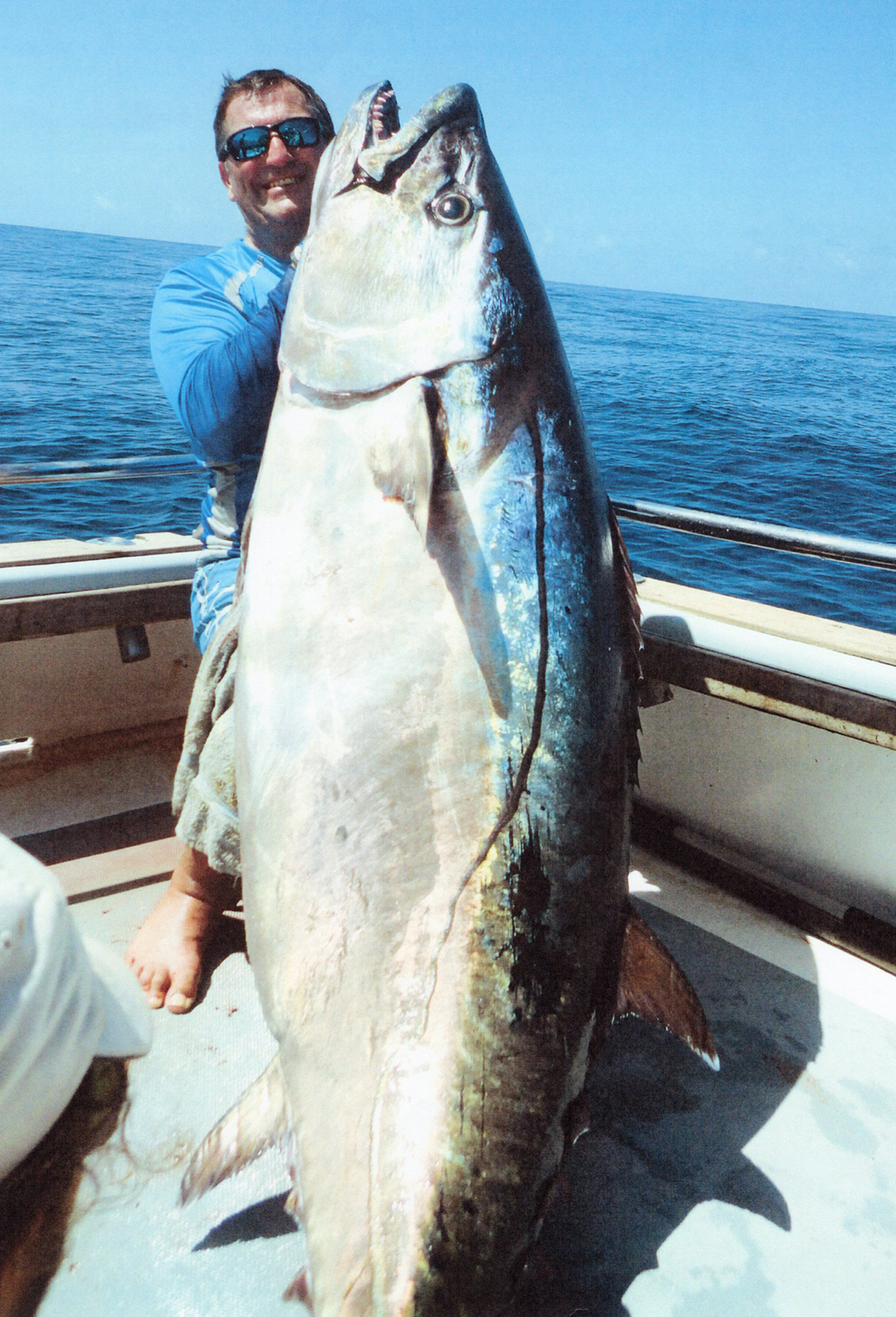
Jon Patten is the reigning all-tackle world record holder with a 236-pound, 15-ounce dogtooth tuna caught Nov. 20, 2015 off Dar es Salaam, Tanzania. The tuna was 86.61 inches long with a girth of 54 inches. Patten used a Fenwick rod, Shimano reel and 80-pound Ande line to land the fish. The bait was a live yellowfin tuna.
Dogtooth tuna are also referred to as scaleless tuna, lizard-mouth tuna, white tuna, vau, atu, kidukidu or dadori. It’s actually a species of bonito, and the only one with a swim bladder. They like the tropical and subtropical areas of the Indian and western Pacific Oceans, and have been found from East Africa to Australia and New Guinea and as far north as Japan. They’re named for their large, conical teeth. Anglers catch them around reefs, channels, passes or rocky areas, places with abundant prey fish. Dogtooth tuna have a fighting reputation, often making a long, fast run after hookup, followed by a battle to work them to the boat. According to the IGFA, many dogtooth are caught incidentally by anglers trolling live or dead bait, such as mullet, mackerel or squid, for other species. They’ll also hit spoons, plugs, feathers, and plastic lures.
Longtail Tuna: 79 pounds, 2 ounces

Tim Simpson holds the all-tackle world record with a 79-pound, 2-ounce longtail tuna caught April 12, 1982 off Montague Island in New South Wales, Australia. The fish was 57.08 inches long with a 34-inch girth. Simpson was fishing with a custom rod and a Penn International 50 6/0 reel spooled with 15-kilogram Erskine K line. He was drifting a scad bait when the longtail bit.
The longtail tuna, also called a northern bluefin tuna or oriental bonito, is found in tropical and subtropical waters ranging from the central Pacific Ocean throughout Southeast Asia to the eastern Indian Ocean and Gulf of Aden. Large schools are often found feeding off Australia’s western and northeastern coasts, with smaller schools cruising the coasts of India. It’s a smaller, more elongated fish than the southern bluefin tuna. Longtail tuna are slashers, often seen blasting through dense schools of baitfish in shallow water.
Skipjack Tuna: 46 pounds, 5 ounces

Joeri Van Laken is the all-tackle world record holder with a 46-pound, 5-ounce skipjack caught Nov. 15, 2020 off la Gomera, Spain. The fish was 38.98 inches long with a 29-inch girth. Van Laken used a Mack-2 rod with a Shimano Tiagra reel spooled with Tiagra line. The fish hit a Sirios trolling lure.
Skipjacks are found in tropical and subtropical, deep coastal and oceanic waters, ranging as far south as Argentina and occasionally up toward Cape Cod, Massachusetts in warmer months. They’re also found in the western Atlantic, Indian and Pacific Oceans. Other nicknames include ocean bonito, Arctic bonito, striped tuna and watermelon tuna. Stripes on the belly and the lack of any markings on the back distinguish skipjack tuna from other species. Skipjack are speedy, often feeding aggressively near the surface, sometimes in massive schools. They’re not finicky, readily hitting trolled strip baits, feathers, spoons, plugs, or small whole baits. When they’re near the surface, casting or jigging is also productive.
Yellowfin Tuna: 427 pounds

The all-tackle world record is held by Guy Yocom, who caught his 427-pound fish on Sept. 18, 2012 while fishing near Cabo San Lucas, Mexico. The fish measured 88 inches in length with a girth of 63 inches. Yocom was using a Melton rod with a Shimano Tiagra reel spooled with 100-pound Jerry Brown line. He caught the fish by chunking.
Another noteworthy yellowfin world record, the 4-pound line class record, is held by John E. Richardson who caught a 64-pound, 4-ounce fish on June 9, 2011 while fishing in Panama’s Piñas Bay. This fish was 47.25 inches long with a 33-inch girth. Richardson was using a custom-built rod, a Shimano TLD reel and Ande line. He caught the fish by casting a live blue runner.
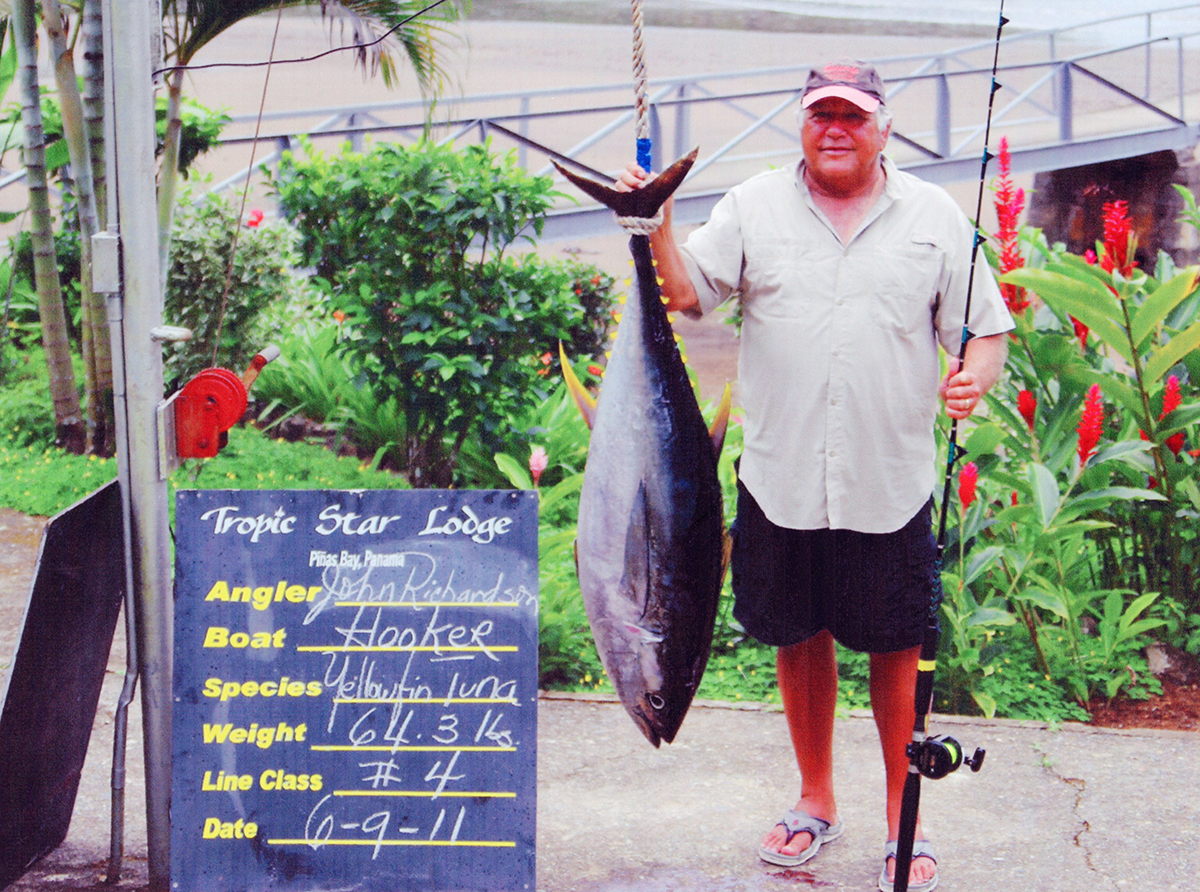
Yellowfin tuna, sometimes called Allison tuna, are among the most popular pelagic sportfish in the world. They’re favorites in the Gulf Stream off the East Coast, and they’re favorites on the grill and dinner table. IGFA says the yellowfin is probably the most colorful of tuna, with a blue-black back that fades to silver on the lower flanks and belly, along with a golden yellow or iridescent blue stripe that runs from the eye to the tail. The fins and finlets are predominantly golden yellow. Fishing methods include trolling with small fish, squid, or other trolled baits such as strip baits and artificial lures. Fishing with live bait is also an effective strategy.
Little Tunny: 36.99 pounds

Angler Lorenzo Roca Moreno caught theall-tackle word record little tunny on June 26, 2020 while fishing off La Ametlla de Mar in Tarragona, Spain. The fish weighed a fraction of an ounce under 37 pounds. The fish was 39.76 inches long and had a 27-inch girth. Moreno was fishing with a Centaur rod and a Daiwa Saltiga reel spooled with 50-pound Relix line. He caught the little tunny on a sardine bait.
Little tunny are often referred to as false albacore. They are common in tropical and warm temperate waters of the Atlantic Ocean from New England and Bermuda to Brazil and from South Africa to Biscay or Great Britain. They are also found in the Mediterranean. Little tunny have distinctive wavy, “worm like” markings on the back above the lateral line, from about the middle of the first dorsal fin toward the tail. They sometimes school in the thousands. The way they slash through prey species at the surface contributes to many good “bird shows” with diving seabirds looking for scraps. Catch them by trolling or casting small whole baits, strip baits, or appropriately sized lures such as spoons, plugs, jigs, and feathers. Little tuna have dark, bloody meat. Some like it; many don’t. The strips or chunks often make great bait.
Kawakawa: 33 pounds, 3 ounces

Captain Eric Hawkins is the all-tackle record holder with a 33-pound, 3-ounce kawakawa caught June 28, 2014 off Molokai, Hawaii. The 38.50-inch-long fish had a 27-inch girth. Hawkins was using a Penn rod and Shimano reel spooled with 30-pound Berkley line. He was trolling a C&H Rattle Jet lure.
Kawakawa have many alternative monikers, including wavyback skipjack, eastern little tuna, mackerel, tuna, Pacific little tunny and false albacore. They’re found across the tropical and temperate waters of the Indo Pacific from the Red Sea and South Africa east to Indonesia and Australia, and from Japan and the Philippines through Oceania to the Hawaiian Islands. Kawakawa reportedly like to stay close to land, sometimes hanging around reefs and estuaries. Their backs, near the midpoint of the dorsal fin, have several squiggly lines over a turquoise background.
Albacore: 88 pounds, 2 ounces

Siegfried Dickemann holds the all-tackle world record with an 88-pound, 2-ounce albacore caught Nov. 19, 1977 off Gran Canaria in Spain’s Canary Islands. The fish was 48.43 inches long with a girth of 37 inches. Dickemann was using a Noris-Shakespeare rod and an Osea Line 900 9/0 reel spooled with 80-pound line. He was drifting a mackerel when the tuna bit.
Albacore are found worldwide in tropical and warm temperate seas, including the Mediterranean, but sometimes make runs into cooler waters as far north as New England and as far south as southern Brazil. The long pectoral fins of adult fish extend beyond the anal fin, giving them their other nicknames of longfin tuna or long finned tunny. They also lack stripes or spots on the lower flanks and belly, and have a thin, white trailing edge on the margin of the tail fin. Anglers troll feathered jigs, spoons and lures, and they will also entice the tuna with live and whole baitfish—from mullet and herring to sardines. Albacore is prized for its white meat, which is a canned supermarket staple across the United States.

